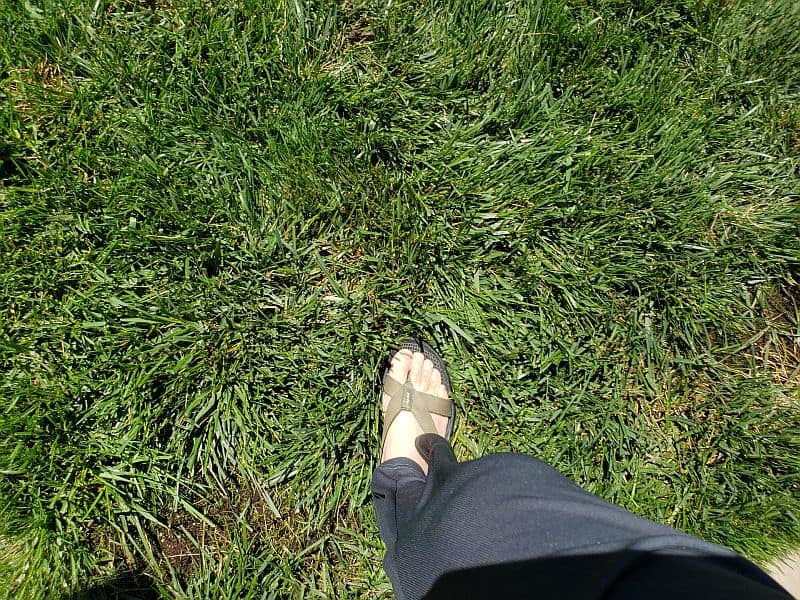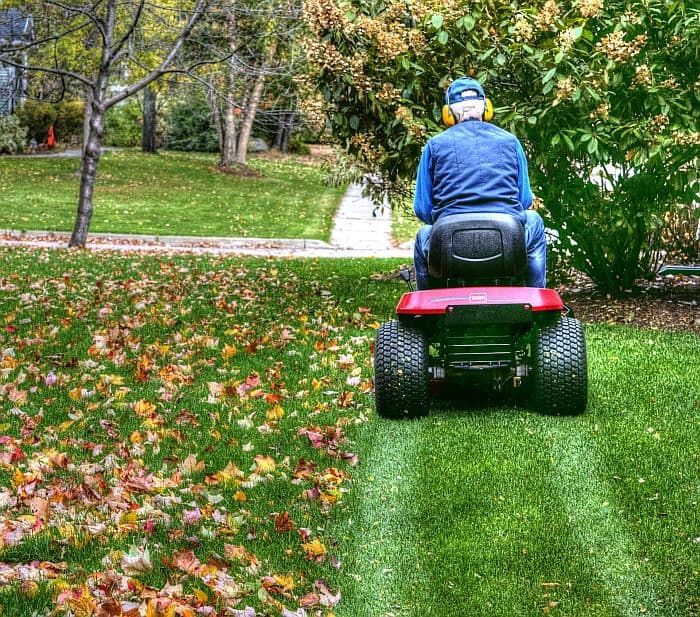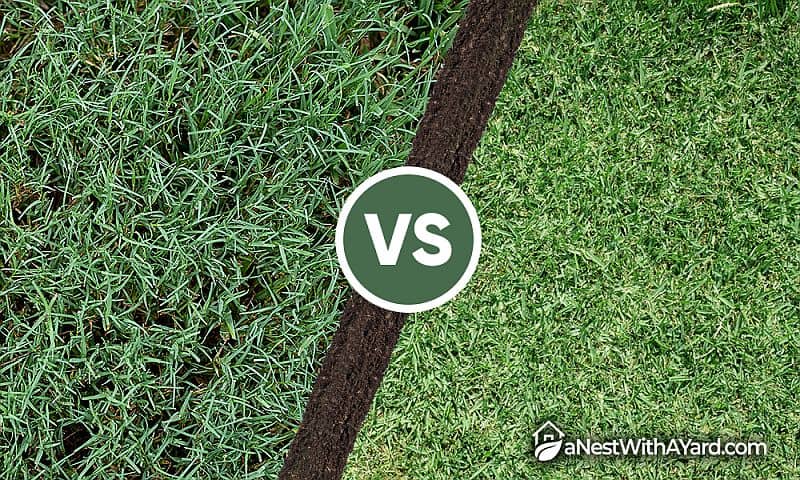Bermuda grass vs St. Augustine grass: Which is better for the average yard? Though both are great for southern states, such as Florida, they each have different advantages and disadvantages.
In this article, I’ll compare the two types of grass and explain why I think bermudagrass is preferable for most yards.
Contents
Bermudagrass And St. Augustine Grass — What’s The Difference?
Bermudagrass
Bermudagrass is a warm-season perennial grass that spreads by seeds, above-ground stolons, and its underground root system. Its leafy, branched stems are generally 4-6 inches (10-5 centimeters tall but can reach 12-18 inches (30-46 centimeters). Its leaves are medium-to-dark green.
If you’re looking for Bermuda grass pictures, bermudagrass looks like this:

Bermudagrass grows well in Zones 7-10, requiring full sun and good drainage. It needs little water when dormant and can tolerate droughts. However, it may go dormant during extended droughts. While bermudagrass prefers a soil pH between 5.8 and 7.0, it can tolerate more alkaline soil.
Compared to St. Augustine grass, bermudagrass needs much richer soil and benefits from more frequent top dressings of compost. However, it needs less nitrogen. HGTV states that annually, bermudagrass needs about one to four pounds of nitrogen every 1,000 square feet. It prefers deep soil but can tolerate moderately shallow soil if properly cared for.
Like St. Augustine grass, bermudagrass is highly tolerant of salt.
Though most of this grass’s roots grow no further than 6 inches deep, they can go as far as 6 feet (2 meters) deep. The extensiveness of its root systems makes bermudagrass especially resilient.
Additionally, bermudagrass grows faster than any other warm-season grass, allowing it to quickly recover from heavy use. This makes it a popular choice for athletic fields and golf courses. Don’s Lawns explains how tough it is in this video:
Unlike St. Augustine grass, you can easily plant bermudagrass with seeds. But, like St. Augustine, you can also plant bermudagrass with plugs or sod. You can also use a method called sprigging, where you press sprigs of rhizomes and/or stolons into the soil. A major advantage of this method is that it’s relatively cheap.
Bermudagrass is thought to have come from Asia and can be invasive. You may want to consult your local Cooperative Extension Service office or another plant professional for guidance on growing bermudagrass where you live.
Pros:
- More cold-tolerant than St. Augustine grass
- Drought-tolerant
- Handles foot traffic well
- Requires less water than St. Augustine grass
- Can be planted with seeds
- Needs less fertilizer than St. Augustine grass
- Chokes out weeds
Cons:
- Requires richer soil than St. Augustine grass
- Doesn’t tolerate shade
- Doesn’t hide weeds as well as St. Augustine grass
- Can be invasive
St. Augustine Grass
St. Augustine grass is a dark green, warm-season grass with broad blades. If you’re looking for pictures of St. Augustine grass, it looks like this:

St. Augustine grass thrives in Zones 8-10 and is excellent for warm, coastal areas. It thrives in many types of soil, including sandy soil, as long as it’s well-draining. It’s also relatively tolerant of salt. For these reasons, St. Augustine grass is especially popular on the Gulf Coast and in Hawaii.
Like bermudagrass, St. Augustine grass is good at out-competing weeds. Additionally, its wide blades help to camouflage weeds that would look unsightly on other lawns. St. Augustine grass can handle normal, non-repetitive foot traffic.
An important difference between St. Augustine and Bermuda grass is that St. Augustine grass is more tolerant of shade. However, you can’t grow a luscious St. Augustine lawn in heavy shade, as it needs at least four hours of sunlight a day to really thrive.
St. Augustine grass also needs at least twice as much water as bermudagrass. However, this may not be a big deal if your area gets enough rain. Additionally, St. Augustine grass keeps its color longer than bermudagrass during droughts.
When it needs water, its leaf blades may look wilted and/or bluish-gray. Additionally, footprints may remain visible if people walk on it.
HGTV says that annually, St. Augustine grass needs about 3-6 pounds of nitrogen every 1,000 square feet, whereas Lawn Care Academy recommends 4-5 pounds of nitrogen for the same area per year.
Be careful not to over-fertilize St. Augustine grass, as this can lead to diseases or thatch. TeamTurf explains what thatch is and how it can affect your lawn:
Do a soil test before applying nitrogen to any lawn. Additionally, don’t apply fertilizer too late or early in the growing season.
To plant St. Augustine grass, you need sod, plugs, or sprigs and it requires more regular mowing and trimming than bermudagrass. And unfortunately, according to HGTV, it’s a grass especially likely to develop thatch.
They say that depending on the location, you may have to dethatch a St. Augustine lawn annually. Common causes of thatch in St. Augustine grass are over-fertilization, wrong soil pH, and excessive watering.
St. Augustine grass goes dormant in soil temperatures below 55F (13C). It stays green year-round in soil that stays at least 60F (16C).
Pros:
- Good for coastal areas
- Shade tolerant
- Grows well in sandy soil
- Chokes out weeds
- Broad, dark-green blades camouflage weeds
Cons:
- Needs more fertilizer than bermudagrass
- Needs more water than bermudagrass
- Less tolerant of foot traffic than bermudagrass
- Can’t be reliably planted with seeds
- Not as cold-tolerant as bermudagrass
- May have to be dethatched more frequently than other grasses
Which Grass Is Better?
Cold Hardiness
Whereas St. Augustine grass thrives in Zones 8-10, bermudagrass can handle Zones 7-10.
Winner: Bermudagrass
Shade Tolerance
If you have a shady yard, go with St. Augustine grass. Bermudagrass requires full sun.
Winner: St. Augustine grass
Foot Traffic Tolerance

Bermudagrass is popular for sports fields because it’s so tolerant of foot traffic. St. Augustine grass doesn’t handle repeated foot traffic as well.
Winner: Bermudagrass
Upkeep Costs

Bermudagrass requires less water and fertilizer than St. Augustine grass. It can also be mowed less frequently. However, HGTV states that bermudagrass needs richer soil conditions and benefits from more frequent compost top dressings.
Winner: Bermudagrass
Drought Tolerance
Not only does bermudagrass need little water when dormant, but it can tolerate droughts better than St. Augustine grass can. St. Augustine requires almost twice as much water as bermudagrass.
Winner: Bermudagrass
FAQs
Will Bermuda Take Over St. Augustine?
Under the right conditions, bermudagrass can take over St. Augustine grass. However, the reverse can happen depending on your local climate, soil, and how well you nurture either grass.
Will Bermuda Grass Kill St. Augustine?
Bermudagrass is a highly invasive plant that spreads by seeds, above-ground stolons, and its underground root system. If left unchecked, it can kill St. Augustine grass.
How Do You Keep Bermuda Grass From St. Augustine?
You can keep bermudagrass from taking over St. Augustine grass by setting your mower at 4 inches and mowing twice per week. The bermudagrass may die in the shade of the St. Augustine grass’s blades.
Which Grass Will You Choose?
Bermuda grass vs St. Augustine: which one will you choose for your lawn?

Use bermudagrass if:
- You live in Zone 7
- Your area has frequent droughts
- The planting area has heavy foot traffic
- The planting area receives full-sun
Use St. Augustine grass if:
- You live in Zone 8, 9, or 10
- You live in a coastal area
- Your lawn area is shady
- Your lawn area has low-to-normal foot traffic

